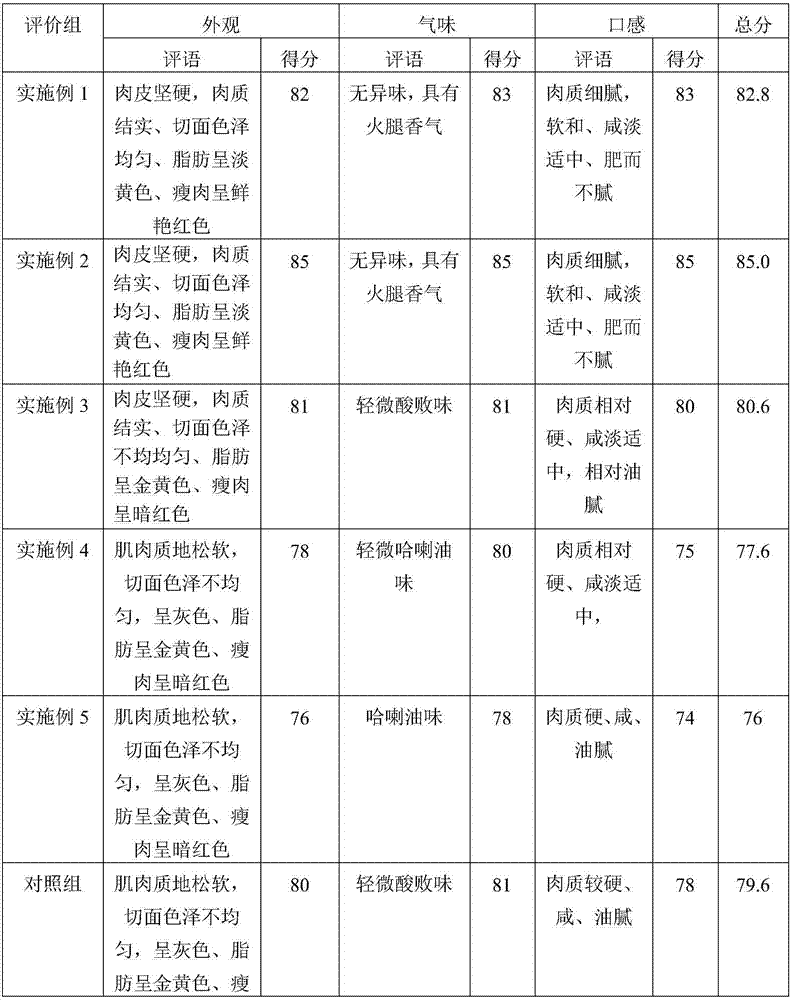Processing method of ham
A processing method and ham technology, applied in food science, climate change adaptation, food ingredients as color, etc., can solve problems such as difficult to meet food safety standards, difficult to meet market demand, high salt content in ham, and achieve soft and delicate taste. High-quality color, delicate meat effect
- Summary
- Abstract
- Description
- Claims
- Application Information
AI Technical Summary
Problems solved by technology
Method used
Image
Examples
Embodiment 1
[0033] A processing method for ham, comprising the following steps:
[0034] 1) Material selection and trimming: In late winter and early spring, pig hind legs with thin skin, thin skin, less fat, bright red muscles, and a mass of 6-7kg are selected as raw materials to remove residual hair, dirty blood, The hoof shell, pubic bone, and tail vertebrae, the surface and edges of the pig's legs are trimmed neatly, and the legs have to be trimmed;
[0035] 2) Soaking: Soak the trimmed legs in solution 1 for 5 hours, filter out the trimmed legs, hang to dry, and soak the legs;
[0036] 3) Marinate: marinate the soaked legs with the mixture to obtain marinated legs;
[0037] 4) Wash the legs and dry the legs: soak the marinated legs in 15°C water for 7 hours, wash off the mixture and greasy dirt on the marinated legs, and dry the washed marinated legs for 5 days;
[0038] 5) Fermentation: The hams dried in the sun are placed on the shelves, and fermented for 70 days in a room with a...
Embodiment 2
[0058] A processing method for ham, comprising the following steps:
[0059] 1) Material selection and trimming: choose pig hind legs with thin skin, thin skin, less fat, bright red muscles, and a mass of 6-7kg as raw materials to remove residual hair, dirty blood, hoof shells, pubic bones, and tail vertebrae on the pig legs , trim the surface and edges of the pork leg neatly, and trim the leg;
[0060] 2) Soaking: Soak the trimmed legs in solution 1 for 6 hours, filter out the trimmed legs, hang to dry, and soak the legs;
[0061] 3) Pickling: marinate the soaked legs with the mixture to obtain marinated legs;
[0062]4) Wash the legs and dry the legs: Soak the marinated legs in 17°C water for 9 hours, wash off the mixture and greasy dirt on the marinated legs, and dry the washed marinated legs for 6 days;
[0063] 5) Fermentation: The hams dried in the sun are placed on the shelves, and the hams are fermented for 80 days in a room with a distance of 2.4m from the ground an...
Embodiment 3
[0083] A processing method for ham, comprising the following steps:
[0084] 1) Material selection and trimming: choose pig hind legs with thin skin, thin skin, less fat, bright red muscles, and a mass of 6-7kg as raw materials to remove residual hair, dirty blood, hoof shells, pubic bones, and tail vertebrae on the pig legs , trim the surface and edges of the pork leg neatly, and trim the leg;
[0085] 2) Soaking: Soak the trimmed legs in solution 1 for 6 hours, filter out the trimmed legs, hang to dry, and soak the legs;
[0086] 3) Marinate: marinate the soaked legs with the mixture to obtain marinated legs;
[0087] 4) Wash the legs and dry the legs: Soak the marinated legs in 17°C water for 9 hours, wash off the mixture and greasy dirt on the marinated legs, and dry the washed marinated legs for 6 days;
[0088] 5) Fermentation: The hams dried in the sun are put on the shelf, and the ham is 2.4m away from the ground, and the indoor air circulation speed is 2-3m / s, and t...
PUM
 Login to View More
Login to View More Abstract
Description
Claims
Application Information
 Login to View More
Login to View More - R&D
- Intellectual Property
- Life Sciences
- Materials
- Tech Scout
- Unparalleled Data Quality
- Higher Quality Content
- 60% Fewer Hallucinations
Browse by: Latest US Patents, China's latest patents, Technical Efficacy Thesaurus, Application Domain, Technology Topic, Popular Technical Reports.
© 2025 PatSnap. All rights reserved.Legal|Privacy policy|Modern Slavery Act Transparency Statement|Sitemap|About US| Contact US: help@patsnap.com


